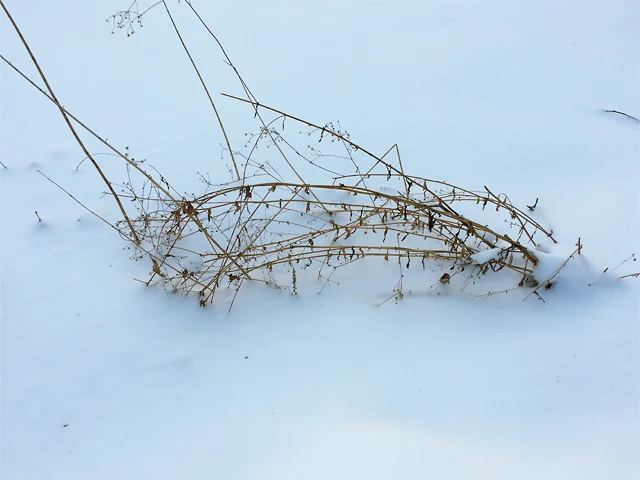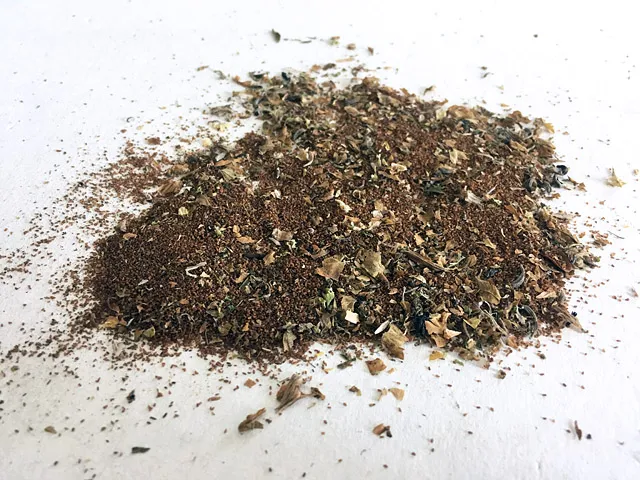Peach Blossom Spring
Things move slowly, we know, but still we expect change to come quickly. Yet quickly comes change, not often the kind we anticipate.
At home, winter is still thick as the lake ice under trucks and shacks. Two years ago this area was cleared to put up the new shop and studio. In 2016 I fall-planted milkweed and transplanted goldenrod, then winter-seeded a mix of savanna seeds in early 2017. By summer we had five foot tall goldenrod, the quickly germinating black-eyed susan, and the beginnings of a more complex blend of plants. I weeded to keep out the Canada thistle, canary reed grass and other more mysterious upstarts.
The winter snow has been permanent, cold as it has been,
sheltering the seeds of milkweed, golderod, rudbeckia, and monarda
fistulosa. It is one way to plant, if you can give it over to the plants and their fecundity or lack of it. If you want to get plants going with an efficient use of a dollar, avoid buying plants, bare roots, or the daunting germination codes M, E, F, G, or ?, stay off wet soils, weed when needed, and let the plants do the work.
The tiny seeds of eastern forest native Lobelia siphilitica, great blue lobelia, collected from the garden last fall. Despite having enough of these self-seeding, locally native plants to start new colonies, I am seeding it in trays this April because it will do well in sunny, wet soils and shady, mesic zones, is untouched by deer, is competitive with weeds and, with luck, garlic mustard and thistle. These seeds have the germination code C(60) and D, meaning that they will require cold stratification (as in nature) of at least 60 days, they are quite small and may require light to germinate. I will regret mixing these with damp silica sand, as they are... quite small. Next time, all code D seeds will be put on damp, white coffee filters for stratification.
In addition to the fifteen or so species collected, bagged and stratifying as I write, another twenty species has arrived from the local native seed supplier, Prairie Moon, yesterday. My first season I concentrated on milkweeds, last year on forbs and grasses, and this upcoming season on forbs and sedges. All are intended for woods, savanna, or wetland edge gardening as I make small dents in the garlic mustard and buckthorn. Come April, these seeds will be greenhouse trayed for sprouting, then moved outside. Most won't be planted until late summer or early fall in locations previously cleared of weeds.
I will end this rambling with a bit of a poem by Tao Yuanming -the 4th century writer of The Peach Blossom Spring, a tale of utopia in a time of political disunity.
I am now, roughly a year, working in education at the Minnesota Landscape Arboretum. Here stands the red barn, a relic of an old farm since annexed. The tracks lead you to the Tashjian Bee and Pollinator Center, where we hold classes for adults in a variety of subjects connected to the institutional mission and serve thousands of school children every year. My focus is the advancement and deepening of photography education. I develop classes, hire teachers, and offer insight wherever I have more than two cents to offer. This satellite of the main campus is in development around agriculture, home grown produce, cooking and methods for preservation. It soon will not be the quiet place it appears to be, but occupied by new buildings, agriculture extension staff, visitors, chefs, meals, and fields of produce. Change here will come quickly.
At home, winter is still thick as the lake ice under trucks and shacks. Two years ago this area was cleared to put up the new shop and studio. In 2016 I fall-planted milkweed and transplanted goldenrod, then winter-seeded a mix of savanna seeds in early 2017. By summer we had five foot tall goldenrod, the quickly germinating black-eyed susan, and the beginnings of a more complex blend of plants. I weeded to keep out the Canada thistle, canary reed grass and other more mysterious upstarts.
The tiny seeds of eastern forest native Lobelia siphilitica, great blue lobelia, collected from the garden last fall. Despite having enough of these self-seeding, locally native plants to start new colonies, I am seeding it in trays this April because it will do well in sunny, wet soils and shady, mesic zones, is untouched by deer, is competitive with weeds and, with luck, garlic mustard and thistle. These seeds have the germination code C(60) and D, meaning that they will require cold stratification (as in nature) of at least 60 days, they are quite small and may require light to germinate. I will regret mixing these with damp silica sand, as they are... quite small. Next time, all code D seeds will be put on damp, white coffee filters for stratification.
In addition to the fifteen or so species collected, bagged and stratifying as I write, another twenty species has arrived from the local native seed supplier, Prairie Moon, yesterday. My first season I concentrated on milkweeds, last year on forbs and grasses, and this upcoming season on forbs and sedges. All are intended for woods, savanna, or wetland edge gardening as I make small dents in the garlic mustard and buckthorn. Come April, these seeds will be greenhouse trayed for sprouting, then moved outside. Most won't be planted until late summer or early fall in locations previously cleared of weeds.
I will end this rambling with a bit of a poem by Tao Yuanming -the 4th century writer of The Peach Blossom Spring, a tale of utopia in a time of political disunity.
The myriad transformations- unravel one another
- And human life
- how should it not be hard?
- From ancient times
- there was none but had to die,
- Remembering this
- scorches my very heart.
- What is there I can do
- to assuage this mood?
- Only enjoy myself
- drinking my unstrained wine.
- I do not know
- about a thousand years,
- Rather let me make
- this morning last forever.




Your progress probably seems slow to you, but from here it looks remarkable. Can't wait to see what the spring brings.
ReplyDeleteLife feels fast. I must inhibit the desire to list all the things that I have moved forward over the last three years -the total is visible, but not as the sum of parts, although there are many parts.
Delete